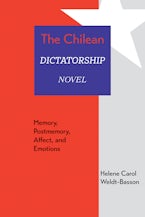- Home
- literary criticism
- Gothic Imagination in Latin American Fiction and Film
Gothic Imagination in Latin American Fiction and Film
Published by: University of New Mexico Press
This work traces how Gothic imagination from the literature and culture of eighteenth- and nineteenth-century Europe and twentieth-century US and European film has impacted Latin American literature and film culture. Serrano argues that the Gothic has provided Latin American authors with a way to critique a number of issues, including colonization, authoritarianism, feudalism, and patriarchy. The book includes a literary history of the European Gothic to demonstrate how Latin American authors have incorporated its characteristics but also how they have broken away or inverted some elements, such as traditional plot lines, to suit their work and address a unique set of issues. The book examines both the modernistas of the nineteenth century and the avant-garde writers of the twentieth century, including Huidobro, Bombal, Rulfo, Roa Bastos, and Fuentes. Looking at the Gothic in Latin American literature and film, this book is a groundbreaking study that brings a fresh perspective to Latin American creative culture.
Carmen A. Serrano is an associate professor in the Department of Languages, Literatures, and Cultures at the University at Albany-SUNY.
"Ultimately, the monograph becomes an indispensable addition to existing criticism. Its success lies in its effective elucidation of significant aspects of Latin American texts that had been overshadowed (or willingly disregarded) by magical-realist and fantastic readings. Thus, Serrano's arguments attest to the ability of the Gothic mode to deepen and enhance academic approaches to international fictions and, particularly, Latin American literature and film."--Inés Ordiz, Brumal: Revista de Investigación sobre lo Fantástico / Research Journal on the Fantastic
"In this groundbreaking study, Serrano . . . rereads canonical Latin American texts through a Gothic lens to elucidate how authors incorporated, adapted, and subverted elements of this aesthetic style as a way of communicating the social and political realities of their particular times. . . . Highly recommended."--Choice
"Serrano offers a timely and ambitious study that rereads classic texts from late nineteenth- and twentieth-century Spanish America. Her analysis astutely identifies the Gothic imagination as a contextually redefined liberating force that speaks truth to power."--Norma Klahn, coeditor of Translocalities/Translocalidades: Feminist Politics of Translation in the Latin/a Américas
"In this engaging discussion of a wide range of authors, Serrano compellingly demonstrates that their texts use the Gothic imagination to articulate social and political realities of their times, especially the corrosiveness of power."--Dorothea Fischer-Hornung, coeditor of Vampires and Zombies: Transcultural Migrations and Transnational Interpretations
"[Serrano] shows how vampiric entities speak to the corrosive effects of power and the societal nightmares they engender. This is a must read for all Latin Americanists and vampire enthusiasts everywhere."--John V. Waldron, author of The Fantasy of Globalism: The Latin American Neo-Baroque
Preface
Introduction. Contextualizing the Gothic Presence in Latin America
Part One. The Context
Chapter One. Vampires: The First Bat-Men Are from the Americas
Chapter Two. Films Love Monsters: Film's Arrival in Latin America
Part Two. Cultural Anxieties and Aesthetic Critiques
Chapter Three. Live Burials and Death-Defying Beauties
Chapter Four. Vampires Cloaked in Metaphor
Chapter Five. The Doppelgänger: Split-Selves, Animal-Doubles, and Spectral Couples
Epilogue. Globalized Current Monsters
Notes
Bibliography
Index







